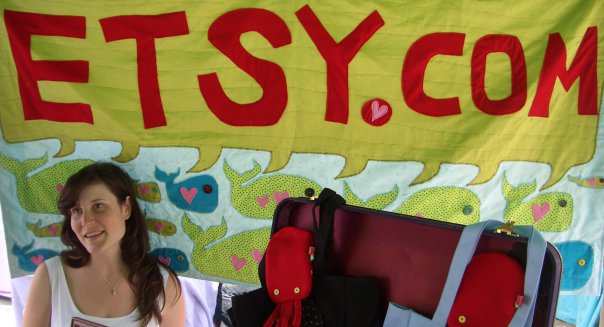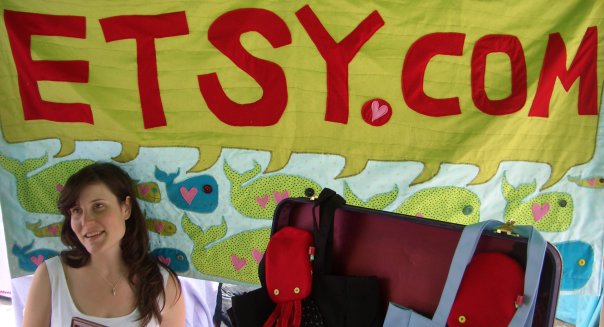
Etsy, the online marketplace where craft mavens offer everything from bohemian wedding dresses to coffee tables built from 200-year-old reclaimed Douglas fir, filed its registration statement on March 4 for an initial public offering. Estimates place the amount to be raised at between $100 million and $300 million. Let’s look behind those numbers.
Based in Brooklyn, New York, Etsy plays an increasingly visible role in the freelance economy, which has grown significantly since the recession of 2008-2009. Etsy allows legions of independent craft entrepreneurs to access a global marketplace. In the company’s IPO filing, it points out that its platform now claims sellers, buyers or both in nearly every country in the world.
How Etsy Makes Its Money
The heart of Etsy’s business model isn’t too far removed from that of online commerce pioneer eBay (EBAY). Etsy gets just over half of its revenue from the 3.5 percent transaction fee it charges sellers on each completed transaction, as well as a 2-cent listing fee for each item presented in an Etsy store.
Most of the company’s remaining revenue comes from services aimed at increasing merchants’ sales. Sellers can pay for favored placement in Etsy’s search results. For a fee, they can also simplify the sales process using Etsy’s Direct Checkout and/or shipping services.
Management is quick to point out that Etsy’s fortunes are tied to those of its merchants. Helping active sellers succeed expands the company’s overall transaction base, which it refers to as “gross merchandise sales,” or GMS.
So while Etsy certainly profits from its menu of upsells to shop owners, the services are designed to promote sellers’ businesses, which in turn help expand Etsy’s GMS. And that GMS is no small pie: Etsy facilitated almost $2 billion in transactions last year.
Given this model, what does Etsy’s bottom line look like? In 2014 the company incurred a loss of $15.2 million on $195.6 million in revenue. Management points out that adjusted EBITDA (earnings before interest, taxes, depreciation and amortization) was positive in 2014, at $23.1 million.
Etsy’s recent profit and loss statements reflect a young company trying to exploit a unique market niche and expand swiftly. The craft transaction house more than doubled marketing expenses last year to $39.6 million. It also poured money into technology, increasing product development expenditures by a third, to $36.6 million. So far, the company’s losses appear to be manageable, and somewhat balanced by positive cash flow. Etsy generated $12 million in cash from operations in 2014.
A Business Risk: Selling More, or Selling Out?
Here’s a simple problem to consider when evaluating Etsy’s growth prospects: If the company is designed to attract buyers of handmade goods, what happens when popular sellers max out their production capacity? After all, handmade crafts are inherently time-consuming to produce.
The company’s solution so far has been to help sellers partner with small-scale manufacturers. Etsy acknowledges that by allowing sellers to expand in this fashion, even when teaming up with “responsible manufacturers,” it may be chipping away at the handmade philosophy that’s driven its success.
But Etsy maintains that it can preserve the “spirit of craftsmanship” even as vendors turn to “small batch manufacturers.” This formula may alienate typical Etsy buyers, whom management describes as not solely price-driven, but valuing “craftsmanship, artistry, uniqueness, authenticity and sustainability.”
On the other hand, the company could conceivably use some of its IPO proceeds to further refine its vision of local, short-run manufacturing. Providing assistance to fledgling manufacturing collectives while proving the positive economic impact of this developing ecosystem would probably resonate with Etsy’s socially conscious buyers.
Positioned for Growth on Several Fronts
Etsy’s IPO filing reflects thoughtful attention to finding new avenues for expansion. Take the recently launched “Etsy Wholesale” business, which matches corporate buyers with approved vendors to supply both boutiques and large retailers with curated, non mass-manufactured goods. Whole Foods Market (WFM) and Nordstrom (JWN) are two high-profile names among the initial participants in Etsy Wholesale.
Over a longer period of time, Etsy seems well placed to take advantage of major technology-centered and economic trends. Of the $2 billion in 2014 transaction volume mentioned earlier, 36 percent of purchases were made on a mobile phone, and 31 percent were completed outside the U.S.
Perhaps the most powerful trend in Etsy’s favor is the rise of female entrepreneurs in both developed nations and emerging economies. According to the World Bank, at least 30 percent of women worldwide in the informal sector (home-based or small-scale businesses) are self-employed. In the U.S., women-owned business are growing at double the rate of all other companies. Etsy swims in the middle of this opportunity: In surveying its own member base using a U.S. sample, the company found that 86 percent are women, and 95 percent run their businesses out of their homes.
Statistics would indicate that many more markets worldwide are ripe for Etsy’s model. For example, in Mexico alone, 30 percent of businesses run by females are operated out of the home, providing a massive base of potential future Etsy sellers.
This company of just 685 employees certainly claims an intriguing space in the evolving global economy. Consider adding the “ETSY” symbol to your portfolio watchlist after its debut this spring. There may be promise yet in putting some investment dollars behind handmade goods.
•The Big Business of Guilty Pleasures
•This ETF Goes for Less Volatility, Luring Anxious Investors
•Investors Should Watch This Trend-Setting Grocery Chain


Leave a Reply